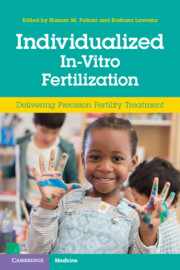Book contents
- Individualized In-Vitro Fertilization
- Individualized In-Vitro Fertilization
- Copyright page
- Contents
- Contributors
- Chapter 1 Individualized Ovarian Stimulation for Normal and High Responders
- Chapter 2 Individualized Ovarian Stimulation in Patients with Advanced Maternal Age and Premature Ovarian Aging
- Chapter 3 Individualized Oocyte Maturation
- Chapter 4 Individualized Luteal Phase Support
- Chapter 5 Individualized Management of Male Infertility
- Chapter 6 Individualized Fertilization Technique in the IVF Laboratory
- Chapter 7 Individualized Genetic Testing
- Chapter 8 Individualized Embryo Selection
- Chapter 9 Preparation for Optimal Endometrial Receptivity in Cryo Cycles
- Chapter 10 Individualized Immunological Testing in Recurrent Implantation Failure
- Chapter 11 Individualized Embryo Transfer
- Index
- Plate Section (PDF Only)
- References
Chapter 2 - Individualized Ovarian Stimulation in Patients with Advanced Maternal Age and Premature Ovarian Aging
Published online by Cambridge University Press: 12 February 2021
- Individualized In-Vitro Fertilization
- Individualized In-Vitro Fertilization
- Copyright page
- Contents
- Contributors
- Chapter 1 Individualized Ovarian Stimulation for Normal and High Responders
- Chapter 2 Individualized Ovarian Stimulation in Patients with Advanced Maternal Age and Premature Ovarian Aging
- Chapter 3 Individualized Oocyte Maturation
- Chapter 4 Individualized Luteal Phase Support
- Chapter 5 Individualized Management of Male Infertility
- Chapter 6 Individualized Fertilization Technique in the IVF Laboratory
- Chapter 7 Individualized Genetic Testing
- Chapter 8 Individualized Embryo Selection
- Chapter 9 Preparation for Optimal Endometrial Receptivity in Cryo Cycles
- Chapter 10 Individualized Immunological Testing in Recurrent Implantation Failure
- Chapter 11 Individualized Embryo Transfer
- Index
- Plate Section (PDF Only)
- References
Summary
Because studies of older and, otherwise, unfavorable patients going through in vitro fertilization (IVF) treatments with own (autologous) oocytes are sparse, we here present to a large degree the subjective experience of only one fertility center in New York City, which as of this point contributed a majority of published studies on this subject. As US national IVF data registries by the Center for Disease Control and Prevention (CDC) and the Society for Assisted Reproductive Technologies (SART) demonstrate, this center serves the by-far oldest patient population among over 500 reporting US IVF centers and, therefore, likely the oldest patient population of any IVF center in the world. While the median age of all US centers reporting to the CDC in 2016 was 36 years, this center’s median age was 42 years in 2016 and 43 years in 2017 and 2018. Over 90 percent of the center’s new patients in recent years reported prior failed IVF cycles, often at multiple centers. Over half of the center’s patients are so-called long-distance patients from outside the larger New York City Tri-State area, many from Canada and overseas. Finally, in excess of 95 percent of the center’s patients suffer from LFOR, which means that even younger patients usually demonstrate abnormally high age-specific follicle-stimulating hormone (FSH) and abnormally low anti-Müllerian hormone (AMH). This center, thus, overall, likely, serves the poorest-prognosis patient population of any IVF center in the world.
- Type
- Chapter
- Information
- Individualized In-Vitro FertilizationDelivering Precision Fertility Treatment, pp. 14 - 29Publisher: Cambridge University PressPrint publication year: 2021



